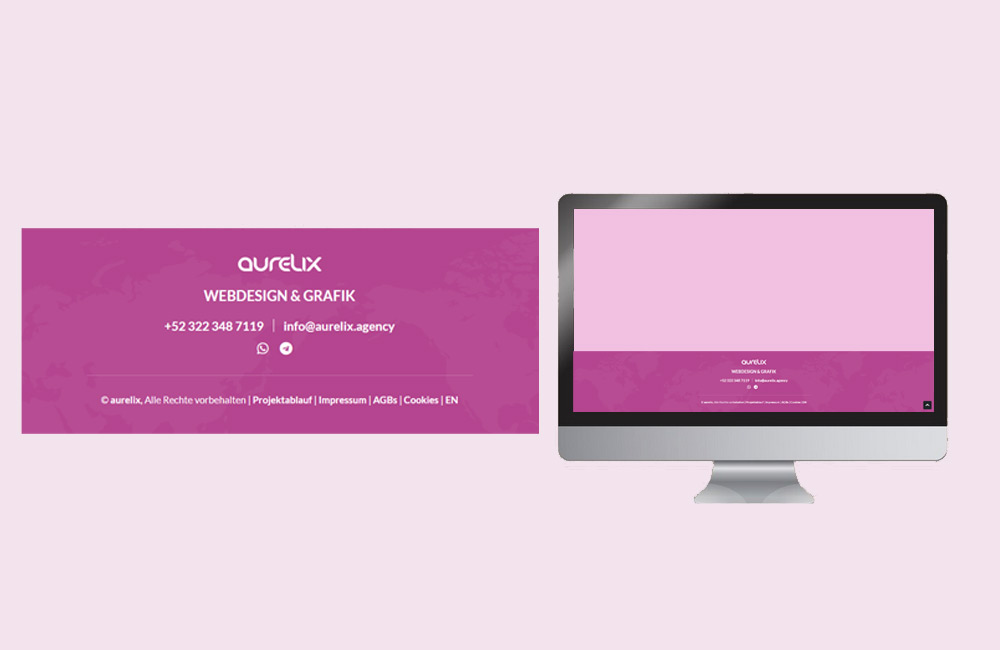The footer is often the most underestimated part of a website — yet it is the foundation of every page. It completes the visit, provides orientation, strengthens trust, and can even improve SEO. A well-structured footer helps users quickly find important information and conveys professionalism and transparency. It can guide visitors to additional pages or actions, directly contributing to conversions. Especially for new users, the footer is often the last touchpoint before leaving the site — which is why it should be planned strategically.
Why the Footer Matters
- Build trust: Legal links, certificates, and contact details show that your business is real and reachable. A visible footer communicates professionalism and security, especially for online shops and service providers.
- Enhance navigation: Footer links lead users to frequently searched pages such as imprint, privacy, or contact. This improves orientation and prevents frustration.
- Boost SEO: Internal footer links help improve site structure and internal linking. A cleanly structured footer helps Google better understand your website’s hierarchy.
- Improve usability: A clear footer gives users orientation at the end of a page. It can also offer quick actions such as newsletter signup or social links.
What Every Footer Should Include
- Logo or brand name – supports recognition and brand consistency.
- Legal links – imprint, privacy policy, terms & conditions, cookie policy.
- Contact information – address, email, phone, or contact form. Visible contact details increase trust and simplify communication.
- Quick navigation – links to key pages like About, Services, Blog.
- Social media icons – for trust, authenticity, and community building.
- Newsletter signup – ideal for lead generation.
- Certificates or trust seals – e.g., SSL, Trusted Shops, TÜV.
Best Practices for Footer Design
1. Structure & Readability
Organize your footer into clear columns or sections. Users should instantly know where to find contact info, legal links, or social icons. Consistent typography, spacing, and dividers improve readability. This keeps the footer structured and pleasant to explore. Avoid clutter — less is often more.
2. Consistent Branding
Use colors, fonts, and logos consistent with your overall design. The footer is part of your brand identity, not an afterthought. A subtle background color provides separation without breaking the visual style.
3. Mobile Display
On smartphones, the footer tends to be long. Prioritize key elements and group secondary links into dropdowns. Buttons and links must be easy to tap to avoid user frustration. Always test on multiple devices.
4. Trust Elements
Seals, reviews, SSL indicators, or partner logos increase trust. Many users scroll to the footer for reassurance. Transparent trust indicators improve conversions.
5. SEO-Friendly Structure
Footer links help Google understand your internal structure. Avoid overstuffing with links — quality over quantity. Anchor texts like “Contact” or “Services” are more effective than generic terms like “here”.
Example Footer Structure
Contact
aurelix
[email protected]
+52 322 348 7119
SEO & Footer
A well-structured footer can support SEO if used wisely. Google evaluates structure, internal linking, and user-friendliness. A clear footer with relevant links signals quality and completeness. You can improve crawling and visibility by linking to less frequently visited pages.
Common Mistakes to Avoid
- Too many or irrelevant links
- Font sizes that are too small
- Missing contact or legal links
- Cluttered or chaotic layout
Conclusion
A thoughtful footer is far more than a placeholder at the bottom — it builds trust, supports navigation, and boosts SEO. At aurelix, I ensure that footers are not only beautiful but strategic: clear, structured, and trustworthy. They strengthen navigation, conversions, and branding — and leave a positive lasting impression.
Further Resources:
Image: freepik.com (adapted)

